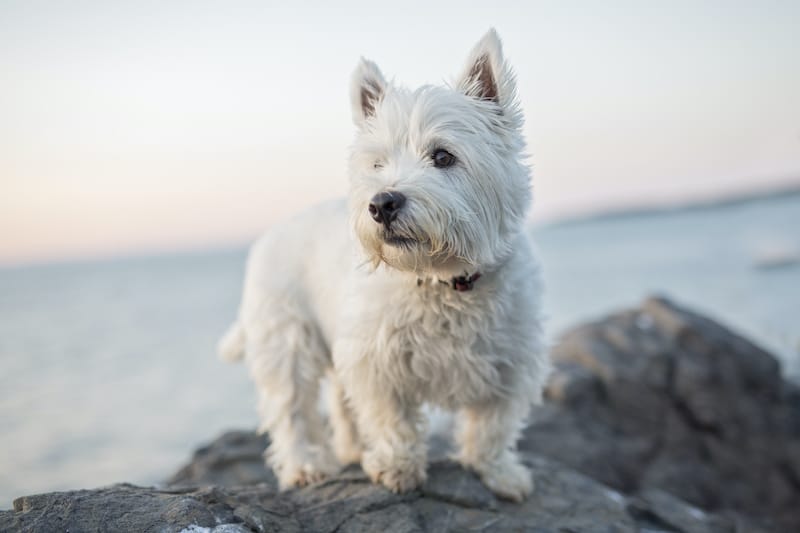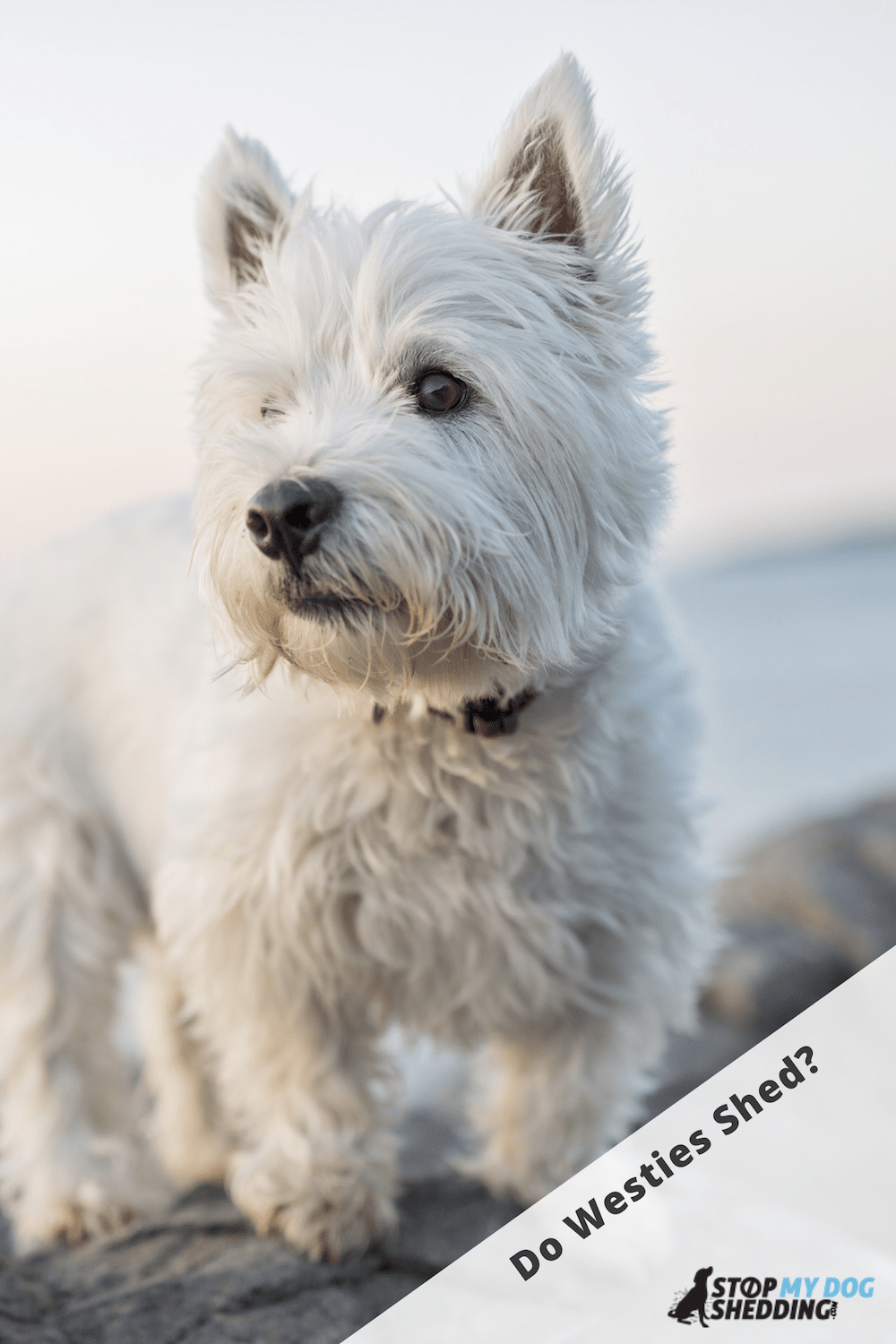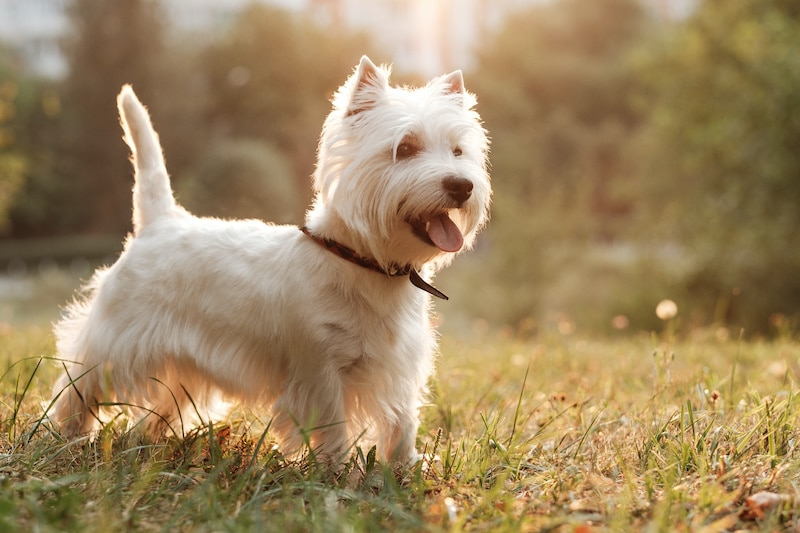West Highland White Terriers (or Westies) are small white coated Earthdogs that were used hundreds of years ago to hunt rats and other rodents in Scotland. Today, they’re more commonly known as loveable family pets and stars in the show ring.
Do they shed? West Highland White Terriers don’t shed much, but it does take a bit of effort to groom them. They have a hard, straight, white outer coat that is about two inches long, and a short undercoat, which needs regular brushing to maintain.
In this article, we’ll be discussing how much shedding to expect from your Westie and what they’re like to groom. So that you can get a better idea on what to expect if you decide to adopt.
How Much Do Westies Shed?
Westies are a low shedding dog breed.
In fact, they are among the lowest shedding breeds in the world, along with dogs like the Poodle, Bichon Frise and Shih Tzu for example.
Some say this is because they have hair instead of fur, but this is simply not the case. For the most part, hair and fur are the same thing. The main difference is just that the word “fur” is used more commonly to describe animals, whereas “hair” is used for humans.
In any case, one of the main determining factors as to how much a dog sheds, is the individual breed and their hair growth cycle. Simply put, the longer the hair stays in the growth cycle (anagen) the longer it tends to grow and the less often it falls out.

In other words, the amount of time it takes for the hair to grow, stop growing, and fall out, is not as rapid in low shedding dogs as it is with higher shedding breeds.
There are other factors that contribute to shedding, though.
Such as the time of year, how healthy the dog is, and other factors like fleas, stress and pregnancy. So it can sometimes be cause for concern, and something you should contact your vet about.
But for most healthy dogs with no underlying issues, how much they shed depends on what breed they are, and time of year. As for the latter reason, some dogs shed seasonally (like in spring and fall) as their body anticipates the change of season.
So you may notice a slightly higher amount of shedding during these times, but nothing close to a heavy shedding dog, like the Chow Chow or Corgi. And overall Westies are suitable for anyone looking for a low shedder.
Are Westies Hypoallergenic?
Westies are not listed as a hypoallergenic breed on the American Kennel Club website. Which doesn’t mean they’re not hypoallergenic, but it does make me a little cautious.
Because, at best, there is no such thing as a completely hypoallergenic dog anyway. Even hairless dogs can cause problems for allergy sufferers. And the reason is because the hair itself isn’t the issue – it’s their dander (dead skin).
Related: Dog Shedding FAQ (What is a Hypoallergenic Dog?)
Dander is considered to be the major cause of dog allergies by most experts. Along with other allergens, like saliva and sweat. So just because a dog doesn’t shed, doesn’t make them hypoallergenic.
With that being said, dogs that produce less dander and shed very little are generally considered more suitable for allergy sufferers. And this does describe the Westie, so it’s safe to say that they are more suitable overall than a heavy shedding dog if you’re looking for a lower allergen dog.
Grooming Your West Highland White Terrier
West Highland White Terriers require regular grooming to maintain their coat.
However, the amount of time and effort required does depend on how fussy you are with the look of his coat, and whether or not you plan on entering him into the show ring.
Why? Well, the traditional method of grooming involves hand stripping. Which is a time consuming, tedious process of essentially plucking the old hairs out of his coat a couple times per year.
To do this, you really only need a hand stripping tool which doesn’t cost much, but this is not recommended for beginners because it takes practice to get the technique dialed in. So, if this is something you are wanting to do, hiring a professional groomer may be worthwhile. At least for the first couple times.
In any case, what most people do is have their Westie clipped instead. Not all the way down, so as to remove the undercoat, but enough to keep the overall length of the coat in check. Particularly around the feet, eyes and ears.
The main benefit of hand stripping versus trimming is that trimming can result in a softer, wavier coat. Which, according to the official breed standard, is a fault. Which only (really) matters if you plan on making him into a show dog.
For general grooming maintenance, a daily brush with a slicker brush or pin brush should be enough to keep his coat mat and tangle free, and remove any dead hairs.
Aside from brushing, the occasional bath with a good quality dog shampoo can help keep his coat in good shape. It’s important not to over bathe though, as this can actually strip his coat of the natural oils and cause dryness, which in turn can lead to excessive shedding.
Recommended: Go here to see our top-rated dog hair blow dryers
Bottom Line
Westies are energetic, intelligent and happy dogs that love people. And he wasn’t just built for snuggles! Back in the day he was actually a very capable hunter. So keep in mind he loves chasing small, fast moving animals.
Either way, if you’re looking for a low shedding dog, and don’t mind spending a bit of extra time (or money) on the grooming side of things, you’ll love welcoming a West Highland White Terrier into your home.
Here are some other small, low shedding dog breeds we’ve written about that may interest you if you’re looking to explore different breeds:
- Havanese (low shedding / high maintenance)
- Norfolk Terrier (low shedding / moderate maintenance)
- Italian Greyhound (low shedding / low maintenance)













Please note: By submitting a comment using the above comment form, you confirm that you agree with the storage and handling of your data by this site as detailed in our Privacy Policy.